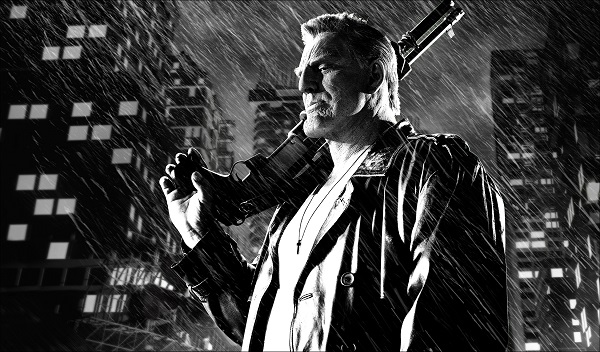Sin City: A Dame to Kill For
Written by Frank Miller
Directed by Robert Rodriguez & Frank Miller
USA, 2014
When Sin City exploded into theaters in 2005, we had never seen anything like it. It was a resounding declaration that digital filmmaking had finally arrived. The new Robert Rodriquez-Frank Miller collaboration, Sin City: A Dame to Kill For, may lack the novelty and humanity of its predecessor, but it still manages to (re)capture the same bonkers spirit. Much like its leading ladies, Dame eventually seduces you with its gorgeousness and gore. It isn’t nearly as accomplished as Sin City, but the amazing visuals and audacious style will help this dame show you a good time.
Frank Miller’s script isn’t a puzzle to be solved so much as a circuitous diversion to mess with your melon. Some of the stories in Dame take place before the events of Sin City, while others pick up well after John Hartigan (Bruce Willis) blew his brains out. The important thing is that we get plenty of Marv (Mickey Rourke), though he’s reduced to a droll killing machine in Dame rather than a tragic anti-hero. Luckily, Rourke’s comedic chops are more than up to the task.
Marv provides the primary through-line for Dame, appearing in all 4 of its stories. In the film’s pre-title sequence, he awakens amidst the wreckage of a car crash, bodies strewn around him, and no earthly idea how he got there. It’s a largely inconsequential sequence that serves only to reacquaint us with this ruthless world, as well as Marv’s pinpoint killing precision. Right away, we know that Rodriquez has a sumptuous visual feast planned for us; a black-and-white orgy of seamlessly blended live action and digitally-rendered backgrounds. As in Sin City, we get the occasional splash of unexpected color, as well as the now-characteristic exaggerated contrast. It’s a breathtaking technical achievement that fully realizes the power of digital filmmaking. The style of Miller’s graphic novels, too, lends itself perfectly to the 3-D format. Whereas 3-D feels like an unnecessary imposition on most films, it makes this noir nightmare feel more vital and immediate.
The second story introduces a new character named Johnny (Joseph Gordon-Levitt). He’s a cocky kid whose uncanny luck earns him a spot at the poker table opposite the uber-powerful and delightfully campy, Senator Roark (Powers Boothe). This is the weakest story in Dame, with Gordon-Levitt lacking the hardboiled presence to pull off such pulpy material. Where this sequence really falls flat, however, is with the script, which relies upon a forgettable love interest and an unbelievable plot contrivance to generate dramatic stakes. This exemplifies why Dame fails to equal the heights (or depths) of Sin City; the humanity has been completely stripped away. Sure, it looks great, and when the blood starts flying and heads start rolling we can overlook the script’s weakness, but we also lack any emotional connection to these characters. We don’t empathize with their plight; their hopeless spiral into the depths of this inescapable hellhole. Nobody is getting out of Sin City alive and, this time around, we don’t particularly care.
The character of Dwight (Josh Brolin) takes center stage in the film’s titular episode. Brolin does a steady job taking over for Clive Owen, who portrayed Dwight in Sin City. His laconic drawl suits the world-weary character, even if the voiceover narration—a heavy-handed attempt at noir embellishment—is laughably bad. But the star of this story is Dwight’s ex-lover and femme fatale extraordinaire, Ava (Eva Green). Indeed, Green is the shining jewel… the dame in Sin City: A Dame to Kill For. She oozes sex appeal and menace so effortlessly that even she seems bored with the easily-corrupted men surrounding her. Green, who spends a good portion of her screen time sans clothing, has always been adept at using her body to convey both power and vulnerability. She’s absolutely fearless here. The script ultimately fails her character (as it does every other female character), but Green proves that she is, indeed, a dame worth killing for.
Finally, we get the re-emergence of Nancy (Jessica Alba), who was understandably bummed when Hartigan killed himself. In between her listless erotic dance routines, she fantasizes about killing Roark. Alba doesn’t get much to do here; she’s mainly the eye candy in a one-note revenge thriller. Willis gets to come back as the ghost of Hartigan—a sort of psychic advisor to Nancy, if you will. This might seem like a stretch until you consider that Willis has already been a ghost of his former self for the last 10 years.
All the humanity and characterization that added depth to Sin City is long gone; replaced by bigger visuals, bigger action and bigger body counts. Rodriguez has crafted a film that is literally all style and no substance. Even his actors seem lost in the scenery at times; adrift in a haze of green-screen debauchery. Still, much like Besson’s Lucy earlier this summer, this Dame throws so much zany energy at the screen that she practically demands subjugation.
While this franchise has probably played itself out, Sin City: A Dame to Kill For should (mostly) satisfy fans of the first film. It’s got the babes, the kills and enough laughs to keep a smile on your face. It’s even got an inspired cameo by Christopher Lloyd as a crank-addled doctor who’s taken a few too many bad trips. Rodriguez and Miller were never going to top the sensational Sin City, but they’ve given us another opportunity to wallow in the gutter with them. And what a gloriously beautiful gutter it is.




